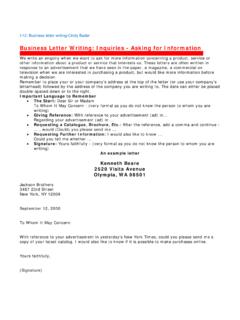Transcription of For More Information Contact: RED MULBERRY
1 When the seedlings are large enough to handle, they can be transferred to big pots in the winter. Then, after the last frost in the spring, they can be planted. When choosing a site to plant Red MULBERRY , take into consideration the messy fruits. It often causes staining of sidewalks and driveways. Also, it needs to be planted in a large space, because of its spreading crown. Pests and Diseases Red MULBERRY is generally free of pests and diseases. Sometimes witches broom will occur. This is caused by a mite and powdery mildew. It does not kill the tree; it just makes the tree unattractive. The main symptom is clusters of abnormally short twigs, which are scattered throughout the tree crown. Pruning out the clusters will help with its appearance.
2 In the Gulf South tent caterpillars will infest Red MULBERRY . For more Information contact : Nicholls State University Camls State University Campus Box 2663 Thibodaux, LA 70310 Phone: 1-800-259-0869 Golden Meadows Plant Materials Center 438 Airport Road Galliano, LA 70354 Phone: (985) 475-5280 Fax: (985) 475-6545 For more Information about other plants, please contact your local NRCS field office or Conservation District, and visit the PLANTS < > and Plant Materials Program Web sites < >. The Department of Agriculture (USDA) prohibits discrimination in all its programs and activities on the basis of race, color, national origin, age, disability, and where applicable, sex, marital status, familial status, parental status, religion, sexual orientation, genetic Information , political beliefs, reprisal, or because all or a part of an individual's income is derived from any public assistance program.
3 (Not all prohibited bases apply to all programs.) Persons with disabilities who require alternative means for communication of program Information (Braille, large print, audiotape, etc.) should contact USDA's TARGET Center at (202) 720-2600 (voice and TDD). To file a complaint of discrimination write to USDA, Director, Office of Civil Rights, 1400 Independence Avenue, , Washington, 20250-9410 or call (800) 795-3272 (voice) or (202) 720-6382 (TDD). USDA is an equal opportunity provider and employer. RED MULBERRY Morus rubra L. For Coastal Wetlands G. Edward Alexander, Jr. USDA-NRCS USDA-NRCS Dr. Malcolm Vidrine, LSUE June 2008 Jeff Trahan WHY RED MULBERRY ? Red MULBERRY is a small, fast growing, native tree found throughout Louisiana in a variety of conditions.
4 But it is mostly found in moist soils of hardwood forests. There are two other species of mulberries found in Louisiana (Black MULBERRY and White MULBERRY ), but they are introduced. Red MULBERRY is the only native MULBERRY in Louisiana. It sometimes hybridizes with White MULBERRY . Red MULBERRY was first described in 1753. It is a good shade tree that is planted as an ornamental because the most important feature of Red MULBERRY is its fruit. The fruits appear from April to June and resemble blackberries. It is a favorite wildlife food, especially songbirds like the chestnut-sided warbler, gray cheeked thrush, Swainson s thrush, Tennessee warbler, scarlet tanager, and veery. The fruits are also edible for humans, if there are any leftovers from the birds.
5 They can be used the same way as blackberry-jams, jellies, plain, wines, etc. In the past, it was used to fatten the hogs and as poultry food. The leaves and twigs provide browse for white-tailed deer and livestock. Also, the leaves provide larval food for two butterflies- mourning cloak and red admiral. The wood is light, soft, weak, close-grained, and durable. It had been used for fence posts, farm implements, cooperage, furniture, interior finish, and caskets. Indians used the inner bark to make ropes, thread, and woven cloth. Description Red MULBERRY is a small to medium-sized deciduous tree that reaches a height of 70 feet and lives up to 125 years. The bark is dark, reddish brown with flat and broad ridges that peel easily in long, narrow flakes.
6 The leaves are alternate, simple, and unlobed, lobed, or mitten-shaped. It is rough hairy above and soft hairy below. The flowers are small, green, and in clusters. The flowers are of two kinds (male or female), on the same or different trees. The fruits are up to 1 inches long and first appear green, then red (hence rubra), and finally deep purple. Propagation and Establishment There are no known cultivars or varieties that are originally from Louisiana available and not many nurseries have Red MULBERRY in stock. However, Red MULBERRY can easily be propagated by seed or by cuttings. Fruit production begins when the trees are 4 to 10 years old. They will continue to produce fruit when they are 30 to 85 years old.
7 Good seed crops are produced every 2 to 3 years. Mature fruits can be picked from the trees from April to June. Seeds can be planted immediately without stratification or in the spring after 30 to 90 day stratification in the refrigerator. The seeds should be planted 8 to 12 inches apart. The average germination rate for Red MULBERRY is 12 to 50 percent. USDA-NRCS USDA-NRCS Dr. Malcolm Vidrine, LSUE



















